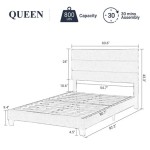Moving Your 2-Year-Old to a Big Bed: A Guide for Parents
The transition from crib to big bed is a significant milestone in a child's development, often marking the end of babyhood and the beginning of toddlerhood. While exciting, this change can also be challenging for both parents and children. Moving a two-year-old to a big bed requires patience, preparation, and a positive approach. This article will provide a comprehensive guide to help parents navigate this transition smoothly and effectively.
1. Timing Is Key
The ideal time to move your child to a big bed is when they show signs of readiness. This can vary from child to child, but some common indicators include:
- Climbing out of the crib regularly
- Expressing a desire for a “big bed”
- Showing independence and self-sufficiency
- Being able to follow simple instructions
It's crucial to wait until your child demonstrates these signs to ensure a successful transition. Forcing the switch before they are ready can lead to more frustration and resistance.
2. Preparation is Essential
Once you decide to make the move, proper preparation is crucial. This involves creating a positive and supportive environment for your child. Key aspects of preparation include:
- Choose the right bed: Opt for a bed that is low to the ground and has sturdy rails to prevent falls. A toddler bed or a twin bed with guardrails can be ideal choices.
- Set up the bedroom: Make the bedroom inviting and comfortable. Consider adding a nightlight, blackout curtains, and familiar bedding. Ensure the room is adequately lit and ventilated.
- Introduce the new bed: Before the actual move, allow your child to explore the new bed, sit on it, and even sleep in their pajamas on it for a few nights. This helps familiarize them with the change.
- Establish a consistent bedtime routine: A predictable routine helps your child feel secure and prepared for sleep. Ensure a consistent bedtime, bath time, and story time routine.
By establishing a supportive and familiar environment, you can minimize anxieties and make the transition smoother for your child.
3. Managing Nighttime Challenges
Despite preparation, some children may experience nighttime challenges after moving to a big bed. These challenges can include:
- Getting out of bed: Toddlers might be tempted to get out of bed and explore. Establish clear boundaries and set expectations for staying in bed.
- Nightmares and sleep disturbances: New surroundings can trigger nightmares and sleep disturbances. Comfort your child and reinforce the idea that they are safe.
- Bedtime resistance: Some toddlers might resist bedtime and protest going to sleep. Remain consistent with routines and encourage independent sleep habits.
Handling these challenges requires patience and understanding. Avoid giving in to tantrums, and maintain a consistent approach to bedtime routines. If issues persist, you can consult with your child's pediatrician or a sleep specialist for further guidance.
Moving a two-year-old to a big bed is a significant step in their development. By approaching this change with careful planning, patience, and a supportive environment, parents can create a positive and successful transition for their child.

Ultimate Guide To The Toddler Bed Transition Taking Cara Babies

Crib To Toddler Bed Transition The Ultimate Check List Forever Freckled

How To Transition A Toddler From Crib Big Kid Bed

Transition From Crib To Toddler Bed Happiest Baby

Ultimate Guide To The Toddler Bed Transition Taking Cara Babies

Gifts Ideas To Help Transition 2 Year Olds A Big Kid Bed The Best Toys For

When To Transition From A Crib Toddler Bed Huckleberry

How To Tackle Double Bedtime When You Re Alone With A Toddler And Baby Today S Pa

Sleep Training A Toddler Methods To Try Transition Tips Naps

The 2 Year Old Sleep Regression What You Should Know







